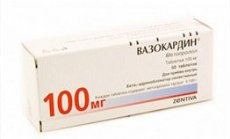Medical expert of the article
New publications
Preparations
Vasocardine
Last reviewed: 03.07.2025

All iLive content is medically reviewed or fact checked to ensure as much factual accuracy as possible.
We have strict sourcing guidelines and only link to reputable media sites, academic research institutions and, whenever possible, medically peer reviewed studies. Note that the numbers in parentheses ([1], [2], etc.) are clickable links to these studies.
If you feel that any of our content is inaccurate, out-of-date, or otherwise questionable, please select it and press Ctrl + Enter.

Vasocardin belongs to the group of adrenergic blocking hypotensive and cardioselective antiarrhythmic agents. Other trade names: Metoprolol, Corvitol, Lopressor, Betalok, Serdol, Egilok, Emzok, etc.
Indications Vasocardine
Vasocardin is used for such pathologies as:
- primary and secondary arterial hypertension;
- angina pectoris (including prevention of attacks);
- hyperkinetic cardiac syndrome;
- heart rhythm disturbances (tachycardia, atrial fibrillation, extrasystole).
Vasocardin can also be prescribed for the prevention and treatment of myocardial infarction (not in acute form), for the prevention of migraines and in the complex treatment of hyperthyroidism.
Pharmacodynamics
The therapeutic effect of Vasocardin is provided by the active substance metoprolol tartrate due to its ability to prevent the binding of catecholamine neurotransmitters to β1-adrenoreceptors. First of all, this leads to a decrease in the frequency and strength of myocardial contractions and stabilizes the balance between the metabolic needs of the heart muscle for oxygen and its delivery by the coronary blood flow.
In addition, the activity of the proteolytic hypertensive enzyme renin is blocked, resulting in a decrease in vascular tone and increased blood pressure.
Pharmacokinetics
The active substance of the drug Vasocardin after oral administration is almost completely (90%) absorbed in the digestive tract; the maximum concentration in the blood plasma is achieved after 1.5-2 hours. Due to the rapid biological transformation of the drug during passage through the liver, its bioavailability after a single dose does not exceed 50%, after repeated administration, bioavailability increases to almost 70%.
Vasocardin is metabolized in the liver, the metabolites do not have pharmacological activity. Metabolites are excreted by the kidneys, up to 10% of the drug is excreted unchanged. The half-life is about 3.5 hours. In case of liver failure, accumulation of metoprolol tartrate in the body is possible.
Dosing and administration
Vasocardin is taken orally, at the same time (preferably in the morning), with a small amount of water. The dose of the drug is prescribed by the doctor individually.
The standard dosage for arterial hypertension, cardiac arrhythmia and angina is 50 mg twice a day; the maximum daily dose is 200 mg.
The standard dose after myocardial infarction is 100 mg twice daily.
 [ 5 ]
[ 5 ]
Use Vasocardine during pregnancy
Use during pregnancy is prohibited.
Contraindications
Vasocardin is contraindicated for use in:
- intolerance to metoprolol;
- arterial hypotension;
- acute myocardial infarction and decompensated heart failure;
- severe forms of local circulatory disorders (endarteritis, vascular stasis, thrombosis, etc.);
- bronchospasm, chronic obstructive bronchitis and bronchial asthma.
Side effects Vasocardine
The use of the drug may cause side effects in the form of sinus rhythm disturbances, a drop in blood pressure, edema, heart pain, shortness of breath, discomfort in the epigastrium, dyspepsia, lipid metabolism disorders, allergic skin reactions, joint pain, increased blood sugar levels, weight gain, impotence, etc.
While taking Vasocardin, it is not recommended to drive a car or operate various industrial machinery that poses a potential hazard.
Overdose
If the dose of Vasocardin is exceeded, nausea, vomiting, a sharp decrease in blood pressure and heart rate, and loss of consciousness are possible. A significant overdose can lead to cardiogenic shock and cardiac arrest. In case of overdose symptoms, gastric lavage and enterosorbents are necessary, as well as intravenous administration of atropine, dopamine, or norepinephrine.
Interactions with other drugs
Vasocardin should not be taken with other blood pressure lowering drugs, as it enhances their effect. Simultaneous administration of Vasocardin with reserpine and cardiac glycosides leads to a slowing of intracardiac conduction and a decrease in heart rate.
The drug should not be taken together with nitroglycerin, tricyclic antidepressants, barbiturate sleeping pills, diuretics, alcohol or alcohol-containing drugs (tinctures).
 [ 6 ]
[ 6 ]
Storage conditions
Storage conditions: in a dark place, at a temperature of up to +20-25°C.
 [ 7 ]
[ 7 ]
Shelf life
The shelf life of the drug is 3 years.
Attention!
To simplify the perception of information, this instruction for use of the drug "Vasocardine" translated and presented in a special form on the basis of the official instructions for medical use of the drug. Before use read the annotation that came directly to medicines.
Description provided for informational purposes and is not a guide to self-healing. The need for this drug, the purpose of the treatment regimen, methods and dose of the drug is determined solely by the attending physician. Self-medication is dangerous for your health.

